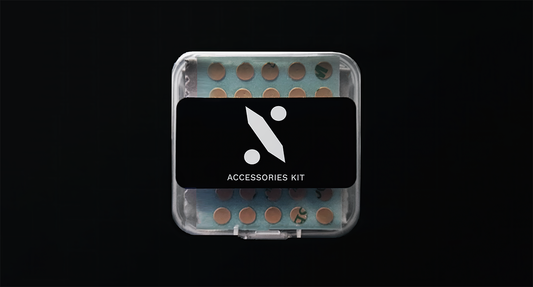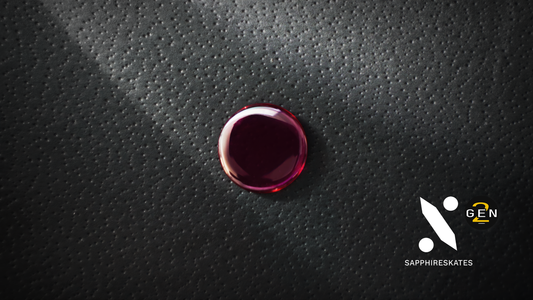In the world of gaming mice, there's widely-accepted industry practices, but is there good rationale behind these conventions? One of these conventions includes the thickness of mouse skates, which are typically either 0.8mm or 0.9mm. This can range even further, all the way down to 0.7mm and upwards toward 1.2mm and beyond. When developing our product SAPPHIRESKATES, this is something we considered, initially designing towards 0.8mm. However, after further research, this isn't necessarily the best approach.
MEASURING THE THICKNESS OF POPULAR GAMING MOUSE SKATES
Let's begin by looking at the thickness of some popular mice feet brands on the market (measured by a micrometer). I've gone ahead and listed a few others that I don't have on-hand, but listed anyways.
- Hyperglides (no adhesive) : 0.7mm
- Corepads - 1.0mm
- G-Wolves Ceramic Skates: 0.8mm
- Lexip (with adhesive) - 1.37mm
- Tiger Arc* - 0.6 - 0.7mm (*stated thickness, not measured)
Stock mouse feet range from about 0.7mm to 0.9mm. So it makes sense that many of the PTFE skates on the market are in this range. The mice manufacturers typically design towards this specification. Is this really the best thickness though?
First of all, the mouse skate thickness isn't the only thing to consider: you have to take into account the thickness of the adhesive as well.
STOCK THICKNESS LEAVES LITTLE MARGIN-OF-ERROR
A big problem with this default 0.8mm thickness is the fact that it only delivers a smooth glide with optimal conditions. I'm sure you've experienced the feeling of when your mouse feet are not applied precisely within the cutout of the mouse channel, leading to scratchiness. Even if they are perfectly applied, it's all too easy for lint to get stuck under the mouse. If this lint is larger in diameter compared to the skates, then your mouse's glide is chalked.
Another challenge with 0.8mm PTFE skates is degradation over time. Since PTFE is a very soft material, gradually, it will compress in a way that is permanent (in physics, known as "plastic deformation"). The first role of mouse feet is to provide a bit of lift so that the mousepad only interacts with a low-friction surface. The next role is to provide an optimal distance for the sensor to track accurately.
TRACKING ACCURACY: WHAT'S THE BEST HEIGHT FOR MOUSE SKATES/FEET?
Here's the real answer to the question about what the thickness of gaming mouse skates should be: it's not about the height of the skates themselves, nor the adhesive, but it's the total distance from the sensor's optical reference point to the tracking surface.
As you can see from the graph below, it's actually somewhat inconclusive as to which height works best. Although most mousepads seem to agree on 2.4mm, some perform the same at 2.8mm while others perform best at 2.1mm!

If you look closer at the graph, you can notice a subtle pattern: soft mousepads have a slight preference towards larger total heights, while hard mousepads require slightly smaller total heights.
What is going on here? The reason for this can be explained by something called 'elastic deformation'. To be clear, this isn't a problem, it's simply the intended behavior. What this means is that as your mouse glides across the mousepad surface, the softness of the mousepad temporarily deforms under the pressure of the mouse feet. This temporary deformation causes decreased z-height from the optical reference point to the tracking surface.
ANOTHER FACTOR: FLEX
In addition to this, you have to take into account the natural flex of the mouse's bottom plate. Typically, the mouse's PCB and sensor is attached to the bottom plate, so if it flexes downwards under pressure, the height decreases too.
To be clear again: this is not a defect with mice. In order to ensure that mice are light enough, some flex is perfectly acceptable. Furthermore, we can see that mice can track relatively accurately in a pretty large range of millimeters.
WHAT'S THE TLDR?
This is all probably more than you need to know about sensor height. But long story short, here's what you should know:
- Within a range of one full millimeter, a gaming mouse can track pretty accurately.
- If you are using a soft mousepad, you should consider using thicker mouse skates to account or the natural "elastic deformation" of the mousepad.
- If you are using a hard mousepad, you may want to use slightly thinner mouse feet, but not thinner than stock because otherwise you can't clear the mouse channel.
- If you are using mouse skates with a larger surface area, this can reduce the flex of the bottom plate so you can get away with using slightly thinner skates too.
- However, if you go too thin, then the mouse will only smoothly glide under optimal conditions (no dust, and requires perfect placement within channel).
WHY WE USE 1.1MM THICKNESS
We (the authors of this article) are in the business of selling mouse skates made of sapphire. The following explanation relates to our own product (we aren't saying that there's a best thickness for other materials.)
- 1.1mm results in a consistent glide, every time, and comfortably clears the mouse's channel, in addition to any debris.
- 1.1mm accounts for the natural elasticity of soft/medium mousepads.
- SAPPHIRESKATES are much more rounded than even the best PTFE skates. This means that the average thickness (rather than the apex thickness) is about 0.8 - 0.9mm.
- The actual total height from the optical reference plane to the mousing surface for soft/medium pads is right in line with Pixart's recommendations at about 2.4mm total. They can also track on hard surfaces without any loss of accuracy.

![SAPPHIRESKATES Gen2 Gaming Mouse Skates [RUBY]](http://sapphireskates.com/cdn/shop/files/sapphireskates-gen2-main-product-with-packaging.png?v=1687476332&width=533)

![HID-Labs Ghost Grip Sheet [Transparent Universal Gaming Mouse Grip]](http://sapphireskates.com/cdn/shop/products/hid-labs-ghost-grip-sheet-mouse-grip.png?v=1665711175&width=533)



